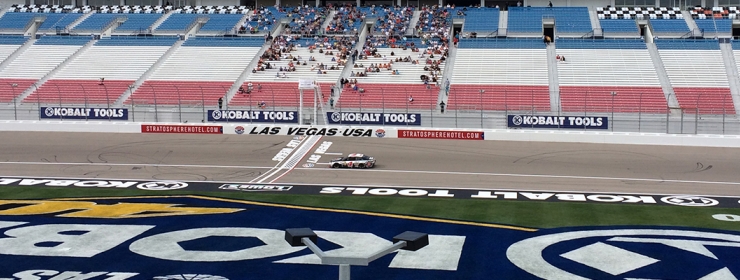
LAS VEGAS – Fresh off his first win of the season, Kevin Harvick turned the top testing speed during Thursday’s four-hour session at Las Vegas Motor Speedway.
The Stewart-Haas Racing driver, winner of last week’s The Profit on CNBC 500 at Phoenix International Raceway, was the only driver to top 190 mph on the 1.5-mile layout, turning in a fast lap of 190.148 mph late in the session.
NASCAR Sprint Cup teams used the opportunity to test the new 2014 rules package for intermediate tracks, where the bulk of this year’s races will be contested.
Sunoco Rookie of the Year candidate Austin Dillon (189.540 mph) was second, while Trevor Bayne,Ryan Newman and Danica Patrick completed the top five.
Sixth through 10th were Cole Whitt, AJ Allmendinger, Clint Bowyer, Jeff Burton and Matt Kenseth.
Defending series champion Jimmie Johnson was 18th overall.
"I think the best thing that happened today is the car didn’t run very fast at the beginning of the practice," Harvick said. "We were three or four tenths off, had to kind of abort on what we were doing and go a different route. The next route was not as good. The third route finally wound up being good.
"I think those are good things that are for us important because they give us direction when we go to other mile-and-a half tracks, so we don’t have to do like we did today. We can get to what has been working for us and go straight from there to progressing that package to make it even better."
The learning experience provided much information, some of which wasn’t what the teams had hoped. While Harvick’s team continued to move forward throughout the day, others found the going a bit more difficult.
Among those was the Roush Fenway Racing contingent of Greg Biffle, Carl Edwards and Ricky Stenhouse Jr.
"It was a pretty tough day for us," Biffle, on the final rundown, admitted. "Last year I was the fastest on Thursday, I was probably third fastest on Friday, 12th on Saturday and I was 25th on Sunday.
"This year I’m 34th on Thursday and hoping that I’m about 20th tomorrow and maybe 12th Saturday and win on Sunday. But that’s about as good of an analogy I can give you on what is wrong with why our fastest car is 27th. I really honestly wish I had more to tell you … we’re just not getting ahold of the race track is about the best I can say."
Edwards checked in 27th fastest while Stenhouse Jr. was 29th.
"Today it’s a half a second (between himself and Harvick), right?" Biffle said.
"We could find some things with the car that’s not right. These cars are really, really finicky, we know that. So that speed could just come up somewhere. That’s what we’re hoping for."
The bigger issue, he said, is that because all three RFR teams were outside the top 25, there’s no helpful information to be gleaned from a teammate.
The fastest Ford entry was that of Bayne in the Wood Brothers Racing entry.
The Team Penske Fords of Joey Logano and Brad Keselowski were 14th and 17th respectively.
"We’ve got to pick a direction because we don’t have guy that’s very fast to take a look at and say 'what do they have?'" Biffle said.
Gene Stefanyshyn, vice president of innovation and racing development, said NASCAR officials were on hand to observe and answer any questions that might crop up. And the results at the end of the day were about what was expected.
"I think the two drivers today kind of gave us good bookends of kind of where the teams are," Stefanyshyn said after listening to comments from Harvick and Biffle. "We know that this will happen any time you give them anything new. There's a bit of a learning curve.
"I think the Harvick team, the No. 4 car, they've got it figured out already, and some of the other guys are struggling."
Last week’s race at Phoenix provided "a glimpse" of the impact of the changes, he said, but noted that it might take until the series moves to Texas in early April before passing judgment.
"Really this will be the first race where … they can fully exploit the aerodynamic and the chassis changes," he said. "So we'll see what happens.
"I think the aero piece of it, it's pretty much set. It's just a matter of getting the driver to find the limit and feeling comfortable with the aero; but the chassis, the engineers will play around with it for a while until that settles down, then the driver will begin to find the sweet spot and get comfortable."
To see this article as it appears on NASCAR.com, click here.